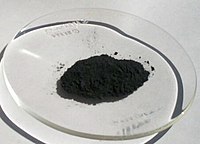
Photo from wikipedia
Abstract Aqueous Zn/MnO2 batteries have attracted considerable attention for large-scale energy storage application owing to their low cost, high safety and environmental friendliness. However, MnO2 cathodes still suffer from the… Click to show full abstract
Abstract Aqueous Zn/MnO2 batteries have attracted considerable attention for large-scale energy storage application owing to their low cost, high safety and environmental friendliness. However, MnO2 cathodes still suffer from the inferior utilization and deficient cyclability at a wide range of current densities. Integrating MnO2 with conductive carbon is promising to overcome the challenges. Unfortunately, the required use of strongly oxidative acids or expensive plasma to functionalize the inherently hydrophobic carbon makes it an obstacle for scalable production. Herein, the hierarchical core-shell carbon nanofiber(CNF)@MnO2 (MOC) nanowires were synthesized by using a facile, controllable and scalable approach combining simple grinding and low-temperature wet-chemical reaction. A synergistic effect was demonstrated for the MOC cathode in Zn-ion batteries (ZIBs). The conductive CNF backbone significantly boosts the electron transfer kinetics, while ultrathin MnO2 nanosheets provide large electrode/electrolyte interfacial contact areas and facilitate the ionic diffusion. Additionally, the intimate contact between CNFs and MnO2 synergistically renders an interconnected network with high electronic and ionic conductivity and flexibility to minimize structural collapse and strain of volume variation upon cycling. The favorable synergistic effect ensures the high capacity, long shelf life, enhanced rate capability and extraordinary cycling stability of MOC. It shows a high capacity of 221 mAh g−1 after 700 cycles at 200 mA g−1. Even at 3000 mA g−1, it still maintains 130 mAh g−1 after 2750 cycles without obvious capacity decay. Featuring the exceptional electrochemical performance, rational design for synergy and low-cost manufacturing, the developed MOC cathode is promising for cost-efficient and high-performance ZIBs.
Journal Title: Chemical Engineering Journal
Year Published: 2021
Link to full text (if available)
Share on Social Media: Sign Up to like & get
recommendations!